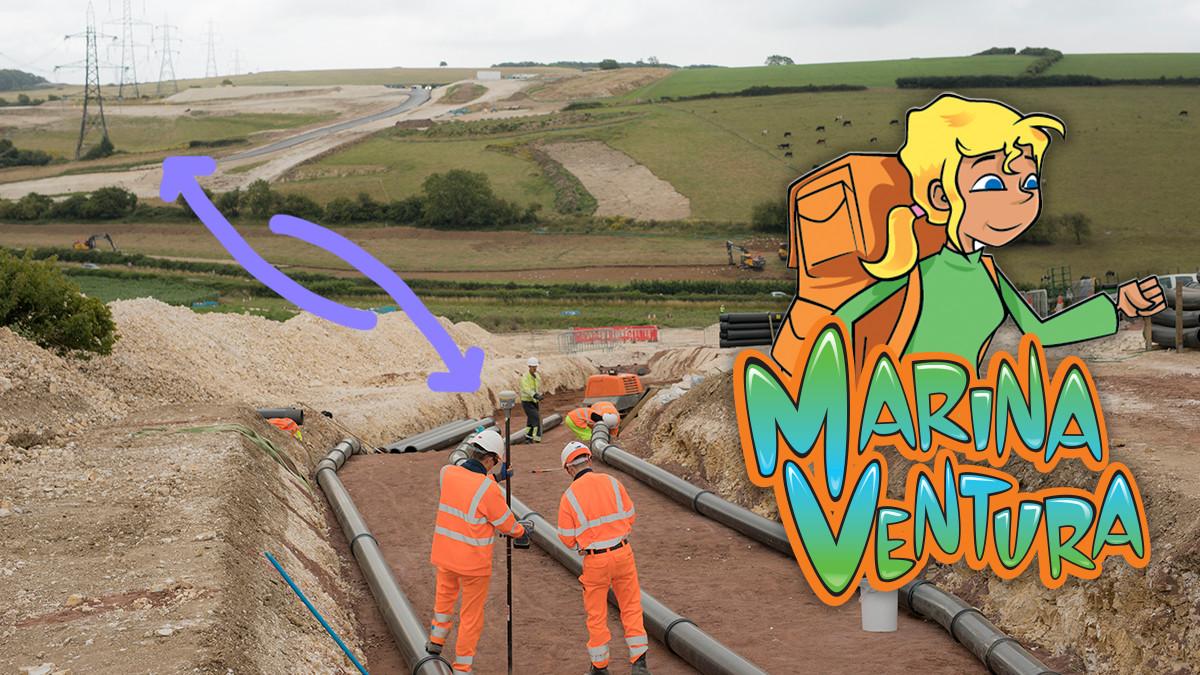
Hi guys! Marina Ventura here. Map App and I are on a mission to explore the WHAT, HOW and WHY about the pylons that help carry electricity from where it’s produced to where’s its needed.
We want your help to come up with some cool designs for an electricity pylon of the future.
There’s lots to think about – it’s design, what it’s made of and how its built. So join us as we find out what makes a perfect pylon!
As we’ve discovered, pylons – those tall metal structures that we see across the country – are vital in helping move electricity around. But not all electricity is carried by pylons – some of the national grid is buried underground.
Whilst 4 ½ thousand miles of the UK’s high voltage electricity transmission system is overhead lines with pylons, a further 870 miles is indeed buried underground.

Why underground?
Pylons are relatively cheap to build and maintain.
Most pylons were built in the 1950s and 60s when the priority was achieving nationwide electrification as quickly and cost-effectively as possible to meet post-war demand and pylons did a good job.
As with many things, there are those who love and those who hate pylons. Rudyard Kipling, who wrote the Jungle Book, once said that pylons were “a permanent disfigurement to our landscape!”
But on the other side of the coin, there’s a club called the Pylon Appreciation Society for people who really like them!
Pylons are certainly quite hard to miss, something that concerns many people especially in Areas of Outstanding Natural Beauty.
So, to help keep these areas looking their best, cables are buried underground. This way, you don’t see tall towers.
Sounds like a simple fix! Not so simple in practice…
It takes a lot of work and money to put the cables underground.
You need to dig deep and wide trenches, which can disturb plants and animals living there.
Over 14 times as much soil, dirt and rubble is excavated for underground cables than overhead ones.
Then, you need to make sure that the underground cables have special protection called insulation to ensure they’re safe so that the electricity doesn’t pose a danger not least to the wildlife and plant life.
A benefit of pylons is that the cables are insulated by air. Nobody can get close to the cables! All that air does another helpful job… keeping the cables cool!
A cable can get hot, you see! As electricity travels along a cable, something known as electrical resistance creates heat, but there’s no cooling air underground! Pumping air underneath the ground would be far too expensive… and noisy!
To help solve the problem, underground cables are generally bigger than overhead cables which reduces electrical resistance and therefore the amount of heat produced. Each cable is well-spaced from others although that means you need quite deep and wide trenches to match the capacity of overhead cables.
In fact, you might need a work area up to 65m wide and that’s much bigger than the footprint of overhead cables!
Benefits of underground cables
There are some areas where it’s not practical to use pylons and also areas of Outstanding Natural Beauty where you want to the countryside to look its best.
As part of some recent developments, pylons have already been removed in the Peak District, and there’s projects to remove them in Snowdonia, the Cotswolds and the West Country.
But in each case, there’s a balance between cost and benefits, so it’s likely that pylons will be with us for a while yet!
Benefits of pylons
It’s hard to bury large cables in built up and industrial areas and you don’t want to dig up sensitive habitats or where there’s archaeological heritage.

There’s also a wildlife benefit with pylons – farmers tend to leave the areas around the pylon bases alone, which become like hedgerows – great places for wildlife and plants to thrive.
Embed from Getty ImagesSo as pylons have a long-term future, what we can do is design them to fit into their surroundings better.
It’s time to design
That’s where YOU come in!
We want you to help us come up with some designs for future pylons.
There’s lots to think about – as we’ve discovered today, cost is an important factor – as well as safety, not to mention thinking about things like heat and insulation.
Why not get scribbling and start your design for a pylon of the future. Have a think about some of the important things to consider.
We can’t wait to see your ideas! Send them to us here.
Watch Emma-Louise design a pylon below…
Listen to Marina Ventura Energy Explorer below!
Marina Ventura Energy Explorer is made with support from Grid for Good by the National Grid.





